Stephanie A. Mann's Blog, page 2
August 7, 2025
Preview: 80th Anniversary of Blessed Rupert Mayer, SJ's Death
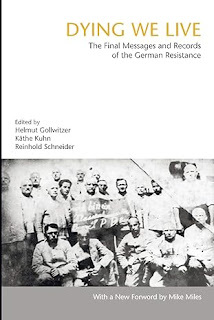 Periodically, the Magnificat prayer monthly includes an excerpt from Dying We Live: The Final Messages and Records of the German Resistance, edited by Gollwitzer, Kuhn, and Schneider. After reading several of those excerpts, I purchased the 2009 Wipf and Stock edition. It is an extraordinary experience reading the letters and journals of these men and women, girls and boys as they face imprisonment, torture, and execution with tremendous peace and faith.
Periodically, the Magnificat prayer monthly includes an excerpt from Dying We Live: The Final Messages and Records of the German Resistance, edited by Gollwitzer, Kuhn, and Schneider. After reading several of those excerpts, I purchased the 2009 Wipf and Stock edition. It is an extraordinary experience reading the letters and journals of these men and women, girls and boys as they face imprisonment, torture, and execution with tremendous peace and faith. One of the last entries in a section titled "Crowned in Death" is by Blessed Rupert Mayer, SJ who died 80 years ago on All Saints Day in 1945.
So, on Monday, August 11, I'll highlight this anniversary in our weekly Son Rise Morning Show segment, as a way to recommend this book and remember his life and sacrifice. You know the drill: I'll be on the air around 7:50 a.m. Eastern/6:50 a.m. Central. Please listen live here or catch the podcast later here.
Rupert Mayer was born on January 23, 1876, in Stuttgart, Germany. Although he heard a call to become a Jesuit when quite young, he obeyed his father and went to college first, then studied for the priesthood. He was ordained in 1899 and joined the Society of Jesus in 1900. After studying in the Netherlands he was assigned to Munich in 1912 and then served as a chaplain during World War I. He was wounded and his left leg was amputated. After the war he returned to Munich.
As early as 1933 Father Mayer began to preach against Chancellor Adolf Hitler's actions against the Church from the pulpit of Saint Michael's, the Jesuit parish in Munich. He was told to stop such preaching and then taken into "protective custody" on June 5, 1937. He was arrested again on November 3, 1939 and taken to the Sachenhausen concentration work camp for political prisoners.
As this blog notes:
After a few months, his health had deteriorated so badly that it was feared he might die in the camp and be seen as a martyr. So he was sent to stay in the Benedictine abbey in Ettal [which this year is celebrating the 125th anniversary of its restoration after the suppression of the abbey in 1803], in the Bavarian Alps. Fr Mayer spent his time there in prayer, leaving his future in the Lord’s hands. He remained in the abbey for almost six years until freed by American forces in May, 1945.
He at once returned to Munich, where he received a hero’s welcome, and took up again his pastoral work at St Michael’s. However, the years in prison and the camp had undermined his health. On 1 Nov, 1945, Rupert was celebrant at the 8 a.m. Mass on the feast of All Saints in St Michael’s. He had just read the Gospel and began preaching on the Christian’s duty to imitate the saints, when he had a stroke and collapsed. Facing the congregation, "The Lord… the Lord… the Lord…" were his last words. He died shortly afterwards. He was 69 years old. While he was first buried in the Jesuit cemetery at the Jesuit house of studies in Pullach, outside Munich, his remains were later brought back to the city and interred in the crypt of the Burgersaal, the church next to St Michael’s, where the men’s Sodality regularly met.
Saint Michael's in Munich offers some details on his beatification:
Father Rupert Mayer was beatified by Pope John Paul II on 3 May 1987, during a service at Munich's Olympic Stadium. In his sermon, the pope told the congregation: "May the spiritual legacy of his life and apostolic ministry always be with you, especially in times of trial, and always give you new strength and confidence in Christ." After the service, the Pope visited Bürgersaalkirche, where he paused in silent prayer at the tomb of the Blessed.The Vatican website has the homily available in Italian and German. Pope Saint John Paul II beatified St. Teresa Benedicta of the Cross (Edith Stein) during that visit too. Father Rupert Mayer's feast day is November 3.
Father Mayer's selections in Dying We Live are from letters written during those different imprisonments, including at the monastery in Ettal--where he was not allowed to participate in the praying of the Divine Office by the monks per the authorities!--but kept hidden from the public entirely. That's how much the Nazi party feared him.
While he was in the penal prison at Stadelheim in June/July 1937, he wrote:
I have now passed through the most beautiful period of my life. One would not believe that possible. I have been happy, completely happy, as never before in my life. . . . (p. 257)Writing to a Gestapo official:
If people could only understand how little it takes to become truly happy inwardly! I have always known that God is good but that he is good in the degree that I have been permitted to experience during the past fortnight, I should never have thought possible. (p. 258)
The most difficult time for him was when he was moved to the monastery at Ettal because of the extreme isolation. He was moved there on August 6, 1940 (the Feast of the Transfiguration!):
Since I exist in a living death; indeed, this death is for me, who am still so full of life, much worse than actual death. . . . I intend to go on carrying my cross and to do penance and atone for my mistakes and my weaknesses, until such time as the dear Lord will intercede to lift this cross from me again. And likewise for the time to come, my watchword will be, "Nearer my God, to thee!" (pp. 262-263)
His favorite prayer was:
Lord, let happen whatever you will;and as you will, so will I walk;
help me only to know your will!
Lord, whenever you will, then is the time;
today and always.
Lord, whatever you will, I wish to accept,
and whatever you will for me is gain;
enough that I belong to you.
Lord, because you will it, it is right;
and because you will it, I have courage.
My heart rests safely in your hands!
So many of the letters and journals from these Christian victims of Nazi oppression echo these sentiments of resignation and rejoicing; confidence and hope: the main regrets their authors express are sorrow for their families, concern that their imprisonment, mistreatment--even torture--and deaths are causing great anguish to their parents, wives, children, brothers and sisters, friends, even fiancées.
Blessed Rupert Mayer, pray for us!
July 31, 2025
Preview: The 135th Anniversary of Saint John Henry Newman's Death
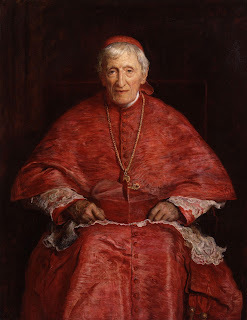 Early yesterday morning the news came that Saint John Henry will be declared a Doctor of the Church soon. Pope Leo XIV accepted the recommendation of the Dicastery for the Causes of Saints that Newman be conferred that title. He will be the 38th saint declared a Doctor of the Church.
Early yesterday morning the news came that Saint John Henry will be declared a Doctor of the Church soon. Pope Leo XIV accepted the recommendation of the Dicastery for the Causes of Saints that Newman be conferred that title. He will be the 38th saint declared a Doctor of the Church. Since one can't be named a Doctor of the Church unless one is declared a Saint and one can't be declared a Saint until after one is dead, it seems appropriate to remember the 135th anniversary this year of Newman's death on August 11, 1890 in our 2025 anniversary series on the Son Rise Morning Show.
So that's what we'll do around 7:50 a.m. Eastern/6:50 a.m. Central on Monday, August 4. Please listen live here or catch the podcast later here.
The New Liturgical Movement website offers some context to the brief announcement made on July 31, 2025:
With this decree, St John Henry becomes the 38th Doctor of the Church, the first Oratorian to be granted the title, the second Englishman, after the Venerable Bede, and the third cardinal, after Ss Bonaventure and Robert Bellarmine. (St Anselm, the eleventh Doctor, is often called “of Canterbury” because of the episcopal see he held, but he was Italian by birth, from the northern region of the Val d’Aosta.) He is also the first Doctor of the Church who converted from Protestantism.
As a reminder, there are three qualities required for a saint to be named a Doctor of the Church: "eminent learning (eminens doctrina), a high degree of sanctity (insignis vitae sanctitas), and a formal proclamation by the Church (Ecclesiae declaratio)" as Father Juan Velez reminds us.
Many Newman scholars have hoped Newman would be named a Doctor of Church, some of them like Erich Przywara, SJ and Ida Friederike Gorres, long before his Cause for Canonization had made much progress. Father Juan Velez also reminds us that "Such a declaration benefits the faithful by highlighting the saint’s teachings and encouraging devotion. The Doctor is added to the Church’s universal calendar." What that will mean for the liturgical calendar in the USA we'll have to see. Newman currently shares an optional memorial with St. Denis and Companions and St. John Leonardi on October 9, the anniversary of his conversion.
[The date of his death, August 11 (in 1890) wasn't used because it's already the feast of St. Clare of Assisi, as a Memorial.]
When Newman died 135 years ago, many praised him, in the Church and even in the British establishment. The Newman Reader offers a collection of contemporary press comments on Newman's death. One highlight is from the The Times of London:
And the Sussex News, highlighting his Oratorian community:
A great man has passed away; a great link with the with past has been broken. Thus enviably closes a most noteworthy life; a life that in itself sums up in the best and most attractive way one side of the religious life of the century. At ninety years of age, full of years, full of honour, but not of honours, in the obscurity of his almost private home, the great man receives the last summons and quietly obeys. A most interesting chapter of our history closes his death, and a life which bears strange testimony to the permanence of certain types in human nature becomes a part of the past. Once more the world is reminded of the degree in which respect and love still attach to the saintly life, when it is coupled with one or another kind of intellectual leadership. Cardinal NEWMAN is literally the last of his generation. Many of his old friends and colleagues he has long survived; others have but lately passed away; but he, to all appearance the most fragile of all, has remained till now. . . .
Will NEWMAN'S memory survive in the estimation of his country? Will his books maintain it? That is a question which may be asked today, but which the future only can answer. Of one thing we may be sure, that the memory of his pure and noble life, untouched by worldliness, unsoured by any trace of fanaticism, will endure, and that whether Rome canonizes him or not he will be canonized in the thoughts of pious people of many creeds in England. The saint and the poet in him will survive. "Lead, kindly Light," is already something better than a classic; the life at Littlemore and at Edgbaston will engrave itself deep into the memory of all to whom religion and lofty human character are dear.
A great Englishman and another of the saints of God has passed to his peace. When JOHN HENRY NEWMAN laid down his long and immortal life's work he was surrounded by young men, any one—or all—of whom would joyfully have given up his own life if it had been possible by such sacrifice to prolong yet a little while the life of the greatest theologian and one of the greatest thinkers of this century. No one who knows anything of the Brothers at the Oratory of S. Philip Neri can doubt this for a moment. Their love for their illustrious and aged chief has scarcely a parallel in these days * * * * * Not in England only but throughout Christendom the death of Cardinal NEWMAN will inspire a feeling of reverent sorrow. He was in his ninetieth year, and it might be said that his work was done; but it is not in human nature to say "Farewell!" without a feeling of grief to such a pure and glorious spirit. In the Christian Church he was the foremost man of his age among the English speaking race, and it is generally agreed among all the most competent critical authorities that he stood before all living prose writers as the master of the English language. . . .
As any future canonized saint should, Newman denied that he that he was one when praised by a correspondent in 1850:
I return you Miss Moore’s letter. You must undeceive her about me, though I suppose she uses words in a general sense. She called Newman a saint. I have nothing of a Saint about me as every one knows, and it is a severe (and salutary) mortification to be thought next door to one. I may have a high view of many things, but it is the consequence of education and of a peculiar cast of intellect—but this is very different from being what I admire. I have no tendency to be a saint—it is a sad thing to say. Saints are not literary men, they do not love the classics, they do not write Tales. I may be well enough in my way, but it is not the ‘high line.’ People ought to feel this, most people do. But those who are at a distance have fee-fa-fum notions about one. It is enough for me to black the saints’ shoes—if St. Philip uses blacking, in heaven.
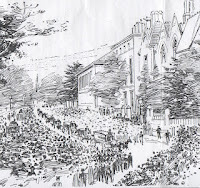 But 20,000 people in Birmingham lined the streets for his funeral procession and even Cardinal Manning, who did not see eye-to-eye with Newman as a Catholic as much as he had when they were both Anglicans, praised him in his funeral sermon:
But 20,000 people in Birmingham lined the streets for his funeral procession and even Cardinal Manning, who did not see eye-to-eye with Newman as a Catholic as much as he had when they were both Anglicans, praised him in his funeral sermon:. . . A noble and beautiful life is the most convincing and persuasive of all preaching, and we have all felt its power. Our Holy Father Leo XIII. knew the merits and the gifts, both natural and supernatural, which were hidden in his humility, and to the joy of all he called him to the highest dignity next to his own.
The history of our land will hereafter record the name of John Henry Newman among the greatest of our people, as a confessor for the faith, a great teacher of men, a preacher of justice, of piety, and of compassion.
May we all follow him in his life, and may our end be painless and peaceful like his.
Saint John Henry Newman, pray for us!
July 24, 2025
Preview: A 475th anniversary, +Abbot John Reeve, and the Fenn Brothers
On Monday, July 28, with the excuse of the 475th anniversary of the founding of one of King Edward VI's Grammar Schools, we'll discuss the dissolution of the monastery of the Abbey of Bury St. Edmunds, the sad death of its last Abbot, John Reeve, and two recusant Catholic brothers, one an exile, the other a martyr! All that (at least some of it!) on the Son Rise Morning Show at my usual approximate time, 7:50 a.m. Eastern/6:50 a.m. Central. Please listen live here or catch the podcast later here.
Last month, the King Edward VI School, Bury St Edmunds celebrated the 475th anniversary of its founding. As the name indicates, it was founded during the reign of King Edward VI, the third Tudor Monarch (1547-1553).
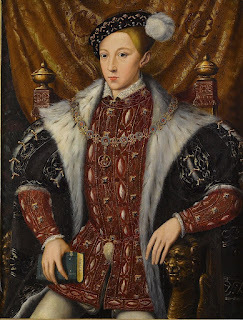 According to the school's website:
According to the school's website:
It is believed there was a school in Bury St Edmunds from the 10th century. In 903 the body of King Edmund was laid in the priests’ college, of which the school was a part. King Canute established a Benedictine Monastery in Bury, and paid from the royal purse for boys of promise, even freed sons of slaves, to attend school. In 1550 lands were given to provide funds for a “scole ther to be founded by the kinges Maiestie in the like manner as the school at Sherbourne”.
King Edward VI School is, therefore, the second King Edward VI School in the country, and in 2000 it had been founded for 450 years. . . . The charter with Edward’s seal is in the Public Records Office together with documents and books from the early years of the school’s existence. One of these is the list of rules for the masters and boys.
Here are a few of the rules for the boys who attended classes that first year:
Sounds tough, doesn't it? The staff didn't have it much easier. According to those 1550 rules: "They shall abstain from dicing, gaming and tippling. They must not keep their family on the premises. Women like deadly plagues shall be kept at a distance."
Those who cannot read and write shall be excluded. They must learn elsewhere the arts of reading and writing. No boy shall come to school with unkempt hair, unwashed hands or dirty shoes or boots, torn or untidy clothes. Any boy misbehaving himself either in Church or any other public place shall be flogged. They shall speak Latin in school. Truants, idlers and dullards shall be expelled by the High Master after a year’s trial. Every boy shall have at hand, ink, paper, knife (used to sharpen a quill pen), pens and books. When they have need to write the boys shall use their knees as a table.
Both of these Edward VI schools--at Sherborne and at Bury St. Edmund's--were founded on the sites of former monasteries. Bury St. Edmund's Abbey was the site of St. Edmund the Martyr's shrine and a great site of pilgrimage from the Twelfth Century until its dissolution in 1539, as the British History Online website explains:
Early in 1538, the agents for [de]spoiling the greater monasteries (in this case Williams, Pollard, Parys, and Smyth) visited St. Edmunds. Writing to Cromwell, from Bury, they tell the Lord Privy Seal that they found a rich shrine which was very cumbrous to deface; that they had stripped the monastery of over 5,000 marks in gold and silver, besides a rich cross bestudded with emeralds and other stones of great value; but that they had left the church and convent well furnished with silver plate. (fn. 80)
On 4 November, 1539, this famous abbey was surrendered. The surrender is signed by Abbot John Reeve, Prior Thomas Ringstede (alias Dennis), and by forty-two other monks. (fn. 81) . . .
On 11 November, the abnormally large pension of £333 6s. 8d. was allotted to the abbot. (fn. 84) He lived, however, only a few months after the dissolution of his house. Weighed down, as it is said, with sorrow and disappointment at the complete degradation of his order, he died on 31 March, 1540, in a small private house at the top of Crown Street, Bury St. Edmunds, never having drawn a penny of his pension. He was buried in the chancel of St. Mary's Church, with a pathetic Latin epitaph on the brass over his remains. The brasses were torn from his grave in 1643, and in 1717 the slab was broken up and the remains removed to make way for the burial of a ship's purser named Sutton. (fn. 85)
So we also commemorate the 485th anniversary of the death of Abbot John Reeve this year. More about him here in a list of ten Abbots of Bury St. Edmunds. Here's a picture of his epitaph in the church, in which Henry VIII's sister and former Queen of France, Mary, is also buried (transferred after the dissolution of the abbey).
May he rest in the peace of Christ--his earthly remains were not accorded any peace.
Back to the founding of the Edward VI Grammar school: According to the school's website, the first High Master was John King (1550-2). Since the school was organized during the reign of Edward VI, I would presume he was a Calvinist in doctrine. But since Edward VI died in 1553, and his elder, resolutely Catholic half-sister Mary succeeded him on the throne, the next High Master was a Catholic.
His name was John Fenn, and he was the brother of a Catholic martyr, Blessed James Fenn. According to the old Dictionary of National Biography Johnwas a native of Montacute, near Wells, Somersetshire. After being educated in the rudiments of grammar and music as a chorister of Wells Cathedral, he was sent to Winchester School in 1547 (Kirby, Winchester Scholars, p. 127; Addit. MS. 22136, f. 21). He was elected probationer of New College, Oxford, in 1550, and two years later, after being made perpetual fellow, he was appointed to study the civil law. It does not appear whether he took a degree in that faculty. In Queen Mary's reign he became schoolmaster at Bury St. Edmunds, Suffolk, but upon the alteration of religion soon after Elizabeth's accession ‘he was forced thence by the giddy zeal of two Scots, that were then settled in those parts’ (Wood, Athenæ Oxon., ed. Bliss, ii. 111). Subsequently he went to the Low Countries, and afterwards studied for four years in Italy, and was ordained priest. Dodd's statement that he was admitted into the English College at Rome is not confirmed by the ‘Diary’ of the college. After his return to Flanders he became confessor to the English Augustinian nuns at Louvain. There and in the neighbouring cities he spent about forty years ‘as an exiled person, doing extraordinary benefit in the way he professed’ (ib. p. 113). He died at Louvain on 27 Dec. 1615.
As easily anticipated by all of you reading this, the next High Master was an Anglican, having taken the requisite oaths. The school is "a Voluntary Controlled Church of England school" to this day and "worship reflects the Anglican tradition" per this source. Alumni of the school are called "Old Burians".
Father John Fenn's brother, the martyr, also had a late vocation to the priesthood, having been married and then a widower (according to the same source):
catholic priest, born at Montacute, near Wells, Somersetshire, became a chorister of New College, Oxford, and afterwards was elected a scholar of Corpus Christi College 31 July 1554, and a fellow of that society 26 Nov. 1558. He was admitted B.A. 22 Nov. 1559, but was ‘put aside’ from that degree and from his place in the college on account of his refusal to take the oath of supremacy (Boase, Register of the Univ. of Oxford, p. 240). Then he settled in Gloucester Hall, where he had several pupils. On being forced to leave Oxford he acted as tutor to the sons of a gentleman in his native county, where he married and had two children. After the death of his wife he became steward to Sir Nicholas Pointz, a catholic gentleman. He arrived at the English College at Rheims on 5 June 1579, was ordained priest at Châlons-sur-Marne on 1 April 1580, and was sent back to labour on the mission in Somersetshire. He was soon apprehended, and although not yet known to be a priest he was loaded with irons. The council ordered him to be brought to London, and after being examined by Secretary Walsingham he was committed to the Marshalsea, where he remained in captivity for two years. His sacerdotal character having been at last discovered, he was brought to trial, and condemned to death on account of his priesthood. He was executed at Tyburn on 12 Feb. 1583–4, together with four other priests. [George Haydock, Thomas Hemerford, John Nutter, and John Mundyn]
Saint Edmund the Martyr, pray for us!
Saint Benedict, pray for us!
Blessed James Fenn, pray for us!
Image source (Public Domain): Portrait of Edward VI of England, seated, wearing a gown lined in fur (ermine or lynx) over a crimson doublet with the collar of the Order of the Garter and holding a Bible.
July 17, 2025
Preview: 140 Years of Perpetual Adoration in Sacre-Coeur
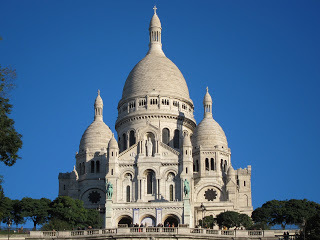
On August 1, 2025, the Basilica of Sacre-Coeur will celebrate 140 years of Perpetual Adoration. To prepare for the anniversary, the basilica will hold a novena of 140 adorers per night before the great celebration, beginning on July 24. We'll talk about this on Monday, July 21 as the next in our Son Rise Morning series of 2025 anniversaries. As usual, I'll be on the air about 7:50 a.m. Eastern/6:50 a.m. Central. Please listen live here or catch the podcast later here.
If you want to book a flight to participate, you also need to book a room in the hostel, especially for August 1, because the events start at 3 p.m. and end after Midnight:
August 1, 2025
3:00 p.m.: Solemn Mass presided over by Cardinal Christophe PIERRE, Apostolic Nuncio to the United States, with Apostolic Blessing granted by Pope Leo XIV.
4:30 p.m.: Grand Eucharistic Procession (bring multicolored rose petals)
5:30 p.m.: Meditated Adoration of the Blessed Sacrament
6:00 p.m.: Solemn Vespers
6:30 p.m. Teaching on the Consecration to the Sacred Heart (At the Crypt. Mandatory, including for renewals of consecration.)
8:30 p.m.: Vigil of Consecration
9:30 p.m.: Compline
10:00 p.m.: Solemn Mass to give thanks to God
11:00 p.m.: Meditated Adoration until midnight
Midnight: Blessing of the faithful and the city with the Blessed Sacrament. Sung Te Deum.
In 2020, Solène Tadié wrote for the National Catholic Register about the perpetual adoration at Sacre Coeur:
Day and night since Aug. 1, 1885, the Body of Christ in the Holy Sacrament has been exposed and adored inside the basilica (except for Good Friday), whatever the external conditions, even the most extreme. This is remarkable, as the history of France hasn’t exactly been calm since that time, including for the Catholic Church, which is also facing an unprecedented wave of secularization at every level of society.
“The adoration hasn’t stopped even for a minute, including during the two world wars,” Sister Cécile-Marie, member of the Benedictine Sisters of the Sacré-Cœur de Montmartre and responsible for the nights of adoration at the basilica, told the Register. “Even during the 1944 bombing, when some fragments fell right next to the basilica, the adorers never left.”
Adoration continued throughout the COVID shutdowns with the Benedictine Sisters taking all the hours until others could enter the basilica. Sister Cécile-Marie highlights the bombing of the basilica in 1944 and that's appropriate because Sacre-Coeur was built after France lost the Franco-Prussian War in 1870, and after the uprisings of the Paris Commune.
The selection of the site for the basilica dedicated to the Sacred Heart of Jesus and Perpetual Eucharistic Adoration, Montmartre, is where Saint Denis, one of the patron saints of Paris, was martyred. The church, built with travertine limestone that exudes calcite when it rains, is bright and white. It's architectural style is Byzantine and the interior is filled with chapels and beautiful mosaics.
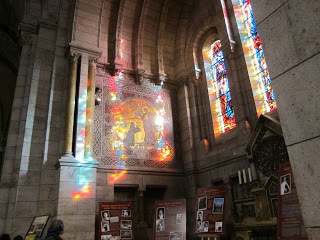
Since it was built with the purpose of reparation for the sins of the French nation, many, like Clemenceau and Zola, opposed its construction, but it was finally completed in 1919. In 2022, Sacre-Coeur was named a national historical monument.
Whenever Mark and I visited Sacre-Coeur, we noted the contrast between the square outside the basilica, with souvenir hawkers and tourists just looking out over the vista of Paris beneath, to the quiet and hush of the church inside, with ushers urging men to take off their baseball caps, and muffled sounds of footsteps around the church.
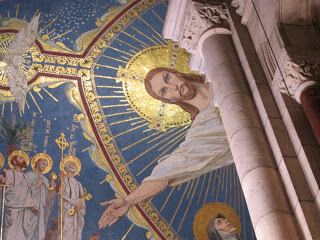
Most Sacred Heart of Jesus, have mercy on us!
July 10, 2025
Preview: Anniversaries of Two Martyrs in England and Ireland
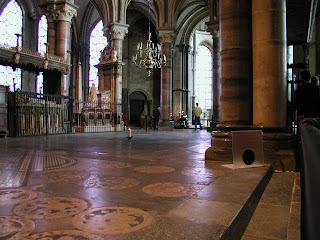 (The candle marks the spot where the great shrine of Saint Thomas of Canterbury once stood, destroyed by Henry VIII's command in 1538, when he suppressed the saint's Cult in England--to effect in the Catholic Church of course.)
(The candle marks the spot where the great shrine of Saint Thomas of Canterbury once stood, destroyed by Henry VIII's command in 1538, when he suppressed the saint's Cult in England--to effect in the Catholic Church of course.)When Thomas More was condemned to death in 1535, he wrote that famous letter to his daughter Meg in which he rejoiced that the date of his execution was July 6, the vigil of one the feasts of Saint Thomas of Canterbury (the translation of his relics into his great shrine after his canonization) and the Octave of the Feast of Saints Peter and Paul:
I cumber you, good Margaret, much, but I would be sorry, if it should be any longer than tomorrow, for it is Saint Thomas' Even and the Utas [Octave] of Saint Peter and therefore tomorrow long I to go to God, it were a day very meet and convenient for me. I never liked your manner toward me better than when you kissed me last for I love when daughterly love and dear charity hath not leisure to look to worldly courtesy.
On Monday, July 7, there was a Catholic Mass celebrated in the Anglican Cathedral of Canterbury (sede vacante since January this year) for the celebration of this feast.
So on Monday, July 14, we'll discuss this anniversary and event on the Son Rise Morning Show; we'll also highlight the celebration in Ireland of the 400th anniversary of Saint Oliver Plunkett's birth! He was the last Catholic priest executed at the end of the Popish Plot hysteria. As usual, I'll be on the air about 7:50 a.m. Eastern/6:50 a.m. Central. Please listen live here or catch the podcast later here.
Catherine Pepinster with Religion News Service began here with the story about this Mass, offered by the Papal Nuncio, Archbishop Miguel Maury Buendia:
LONDON (RNS) — King Henry VIII and his iconoclast-in-chief, Thomas Cromwell, would be stunned: Nearly 500 years after the English Reformation, Canterbury Cathedral, the mother church of the Protestant Church of England, will be given over to a Roman Catholic Mass, celebrated by the pope’s own representative in the country in honor of the martyr Thomas Becket, who died in the cathedral in 1170.Tenebrae provided the chant during the Mass; pilgrims could receive the Jubilee Year indulgence; and the congregation sang the Salve Regina! This was an extraordinary event!
Not least among the historical oddities of the day will be that the Mass will award those in attendance a plenary indulgence.
When Henry broke with Rome in 1535 to create the Church of England, it led to the destruction of shrines to saints and martyrs, including their relics. The tradition of offering pilgrims an indulgence for visiting these shrines — a key driver of the Protestant revolt across Europe at the time — was ended.
St. Thomas of Canterbury was martyred in 1170 (855 years ago this December 29), canonized in 1173, and his relics were moved on July 7 from the crypt to the Trinity chapel in 1220 (805 years ago).
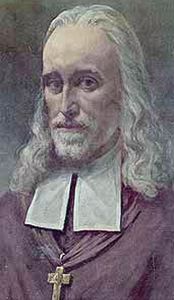
The other great anniversaries are for Saint Oliver Plunkett: the 400th anniversary of his birth on All Saints Day in 1625 and the 50th anniversary of his canonization on October 12, 1975 (he was beatified in 1920!)
RTE reported on July 4 in advance of the events:
The 400th anniversary of the birth of St Oliver Plunkett is being marked in both Drogheda and the Oldcastle area of Co Meath this year. . . .More details here on a special website for the martyred saint.
A series of events is under way to mark 400 years since St Oliver Plunkett’s birth, and also the 50 years since his canonisation in 1975, when he became the first newly-made Irish saint for almost 700 years.
Tomorrow will see an event titled the 'Plunkett Clan Gathering’ take place at Loughcrew House and Gardens, the ancestral seat of the Plunkett family.
An ecumenical service in the 17th-century church will be followed by historical talks, live music and refreshments, which organisers have said will be a "heartfelt tribute in a place of deep personal resonance for the saint’s descendants".
These anniversaries and these events demonstrate the great impact of these martyrs and their legacy for the Catholics of England and Ireland!
Saint Thomas of Canterbury, pray for us!Saint Oliver Plunkett, pray for us!
July 1, 2025
Stumbling Upon Words from Maeterlinck in a Book about Chesterton
Fagerberg is discussing Chesterton and happiness and suggests that "happiness is not so passive; perhaps happiness even has the power to influence destiny." Then he suggests that Maeterlinck offers an insight: "that wise persons know in advance" . . .
how events will be received in their soul. The event itself is pure water that flows from the pitcher of fate, and seldom has it either savour or perfume or color. (from Wisdom and Destiny by Maeterlinck)
Maeterlinck cites the examples of Oedipus and Hamlet: they are not wise enough to respond well to events and yet remain happy: other wiser characters could, but "Hamlet is unhappy because he moves in unnatural darkness." (p. 24)
Immediately I thought one of the unhappiest characters on any stage: Maeterlinck's Mélisande in his play Pelléas et Mélisande and in Debussy's opera of the same name. Her key phrase is some variation on "I am not happy":
Melisande
Je suis...
Je suis malade ici...
Golaud
Tu es malade?
(pause)
Qu'as-tu donc, qu'as-tu donc, Mélisande?
Melisande
Je ne sais pas...
Je suis malade ici.
Je préfére vous le dire aujourd'hui;
Seigneur, je ne suis pas heureuse ici...
And the kingdom of Allemonde is very dark as her husband Golaud admits: so many forests, famine in the land, dark caverns and deep wells, storms off the coast of the dark sea that obscure the beacon lights . . .
Golaud
Qu'est-ce donc?
Ne peux-tu pas te faire à la vie qu'on mêne ici?
Il est vrai que ce château est très vieux et très sombre...
Il est très froid et très profond.
Et tous ceux qui l'habitent sont déjà vieux.
Et la campagne peut sembler triste aussi,
avec toutes ces forêts, toutes ces vieilles forêts sans lumière.
Mais on peut égayer tout cela si l'on veut.
Et puis, la joie, la joie, on n'en a pas tous les jours:
Mais dis-moi quelque chose;
n'importe quoi, je ferai tout ce que tu voudras...
Melisande
Oui, c'est vrai...on ne voit jamais le ciel ici.
Je lai vu la première fois ce matin...
She's just been able to see the sky that day. And when she leaves Golaud on a fruitless errand, she repeats "Oh! Oh! Je ne suis pas heureuse, Je ne suis pas heureuse" and weeps.
There are lots of opinions about Melisande and Debussy's opera is an acquired taste: one either loves it or leaves it (after a couple of acts in the opera house).
It's one of my favorite operas from listening to recordings and opera broadcasts. It's not going to be in a regional or local opera company's repertoire: too risky. Not even the Met in Manhattan stages it that often (119 performances between 1925 and 2019; compare that to another French opera, Gounod's Faust: 752 from 1883-2013. The most performed opera at the Met: La Boheme, 1,440 times from 1900 to 2025.) Yes, there's an online database! (It's not even performed that often at the Paris Opera; it debuted at the Opera-Comique.)
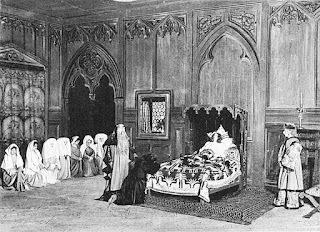
Melisande is not wise (she never knows anything and she'll lie without reason), she lives in darkness, the darkness of Maeterlinck's symbolist world, and she's not happy. Instead of "Hamlet is unhappy because he moves in unnatural darkness" would Maeterlinck say that Melisande is unhappy for the same reason?
At the end of the opera, she wants the windows opened so she can see, see the sun:
Melisande
Ouvrez la fenêtre...ouvrez la fenêtre...
Arkel
Veux-tu que j'ouvre celle-ci, Mélisande?
Melisande
Non, non, la grande fenêtre...c'est pour voir...
Arkel
Est-ce que l'air de la mer n'est pas trop froid ce soir?
Le medecin
Faites, faites...
Melisande
Merci...
Est-ce le soleil qui se couche?
Arkel
Oui; c'est le soleil qui se couche sur la mer; il est tard.
Comment te trouves-tu, Mélisande?
But of course the sun is setting. And it gets in her eyes so she can't see Golaud.
Can you imagine G.K. Chesterton at a performance of Pelléas et Mélisande? It was performed at the Royal Opera, Covent Garden in 1909. If he had seen and heard it, would he have agreed with Arkel in an earlier scene, “si j’étais Dieu, j’aurais pitié du coeur des hommes”. (If I were God, I would pity the hearts of men.)*? Or would he have left at the first intermission?
*Which makes one think of “Behold this Heart which has so loved men that it has spared nothing, even to consuming itself to witness its love."
Image Source (Public Domain): Photograph of Act 5 of the original 1902 production of Debussy's Pelléas et Mélisande, published in Le Théâte, June 1902
June 26, 2025
Preview: Summer Reading Suggestions on Monday
I have two novels and one spiritual reading book to recommend.
 The first novel is The Blue Castle by Lucy Maud Montgomery, the author of the Anne of Avonlea novels. It's kind of a Cinderella story. Valency, a spinster, finally leaves her family home (because she's been told she's dying), takes care of a young girl dying of tuberculosis (who's been ostracized by the community), and then asks a man, Barney Snaith (whom her family suspect of some horrible past) to marry her. He marries her, perhaps out of pity--she does tell him she loves him--knowing she has but a year to live, as the doctor wrote to her.
The first novel is The Blue Castle by Lucy Maud Montgomery, the author of the Anne of Avonlea novels. It's kind of a Cinderella story. Valency, a spinster, finally leaves her family home (because she's been told she's dying), takes care of a young girl dying of tuberculosis (who's been ostracized by the community), and then asks a man, Barney Snaith (whom her family suspect of some horrible past) to marry her. He marries her, perhaps out of pity--she does tell him she loves him--knowing she has but a year to live, as the doctor wrote to her."The Blue Castle" has been Valency's imaginary refuge within her family life, where she's been the drudge and disappointment because of her spinsterhood, and she finds that refuge with Barney as they become friends and grow to love each other. Her other great pleasure has been reading books about nature by John Foster, whom Barney rejects as an expert.
Montgomery fills the book with descriptions of the forest and wildlife surrounding Valency's real Blue Castle, a cabin on an island in a lake, a refuge for both of them.
I won't give away the denouement of course, but it was a moving novel for me to read, especially as it depicted marital love growing from friendship--and a couple who can enjoy sitting together in silent companionship.
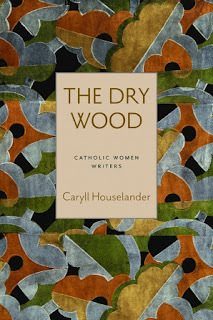 The second novel is
The Dry Wood
by Caryll Houselander, better known as a spiritual writer and mystic. It is part of the Catholic Women Writers series from the Catholic University of America Press. It is her only novel "set in a post-war London Docklands parish. There a motley group of lost souls are mourning the death of their saintly priest and hoping for the miraculous healing of a vulnerable child whose gentleness in the face of suffering brings conversion to them all in surprising and unexpected ways."
The second novel is
The Dry Wood
by Caryll Houselander, better known as a spiritual writer and mystic. It is part of the Catholic Women Writers series from the Catholic University of America Press. It is her only novel "set in a post-war London Docklands parish. There a motley group of lost souls are mourning the death of their saintly priest and hoping for the miraculous healing of a vulnerable child whose gentleness in the face of suffering brings conversion to them all in surprising and unexpected ways."As the editors of the series, Bonnie Lander Johnson and Julia Meszaros, comment in the introduction, The Dry Wood is both very experimental and very Catholic: you can almost smell the incense and hear the bells when Houselander describes a Benediction service (one detail: the congregation watching the altar server light each of the candles on the Altar with great attention!). After starting one story about the deceased parish priest and hopes for the cure of child with painful birth defects, she starts telling about new characters with new plots and incidents. There's more exposition and description than action in some ways, but the narrative still drives forward.
If you've read some of Houselander's spiritual writing, you'll recognize her characteristic insight that we should see Christ's image in everyone, not just those who seem virtuous or pious. One character, Rose O'Shane, works hard, practices great charity, but also drinks a bit too much; she could be judged as not worthy of regard, but Houselander reveals her holiness and helps us see the Christ in her. It's beautifully written and I can't be tempted to share the ending because I haven't finished it as of today.
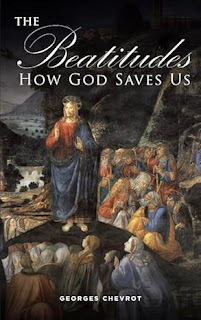 The spiritual work I recommend is by an author, Pere Georges Chevrot of Paris, I just discovered this Easter when a friend and I read and discussed The Easter Impact: How the Resurrection Restores and Strengthens Our Faith. So I obtained and just finished
The Beatitudes: How God Saves Us
:
The spiritual work I recommend is by an author, Pere Georges Chevrot of Paris, I just discovered this Easter when a friend and I read and discussed The Easter Impact: How the Resurrection Restores and Strengthens Our Faith. So I obtained and just finished
The Beatitudes: How God Saves Us
:This is a revised edition of The Eight Beatitudes, published by Scepter Dublin in 1959.
Our duty as Christians is not only to recognize the deep spiritual needs of our world today, but to help solve them through our own dedication to the Beatitudes. This new edition of French author George Chevrot’s THE BEATITUDES lays out in dramatic detail the extraordinary impact that the message of Jesus Christ had on the first witnesses to his public preaching which became known as the Sermon on the Mount.
Jesus calmly lays out a radical program of personal reform, contrary to every experience and teaching up to then. Happiness comes to those who do not seek themselves, but the needs of others. We should not seek to be happy, but blessed, and the key lies in direct service to others.
Above all other considerations, the Beatitudes impose a program of personal struggle which represents the foundation of Christian life. Only when these teachings are lived will society also reflect that Christian life.
In the chapter on "Blessed are the peacemakers", Chevrot offers this fascinating connection: "The seventh Beatitude is like a touchstone which will join the Sermon on the Mount with the Discourse after the Last Supper . . . " (p. 123) as he explicates " . . . the peacemaking mission with which he entrusted us". (p.124) Chevrot matches two of Jesus's statements which we can think are contradictory:
"Peace I leave with you; my peace I give to you." (John 14:27) AND "Do not think that I have come to bring peace on earth; I have not come to bring peace, but a sword." (Matthew 10:24).
Then Chevrot points out, He didn't say he brought "war" instead of "peace". He said He brought a "sword": the efforts, choices, and renunciations that will cost us to create peace. Because peace doesn't mean the absence of conflict: it may take some conflict to create peace.
And in the chapter on the Eighth Commandment, there's an incredible passage on Pilate's "Ecce Homo" presentation, as the Procurator believes Jesus is innocent, but the Elites countermand his attempt at mercy!
As my friend and I agreed when we read The Easter Impact, Chevrot offers unique insights in the support of practical counsel for the Christian life.
June 19, 2025
Preview: Pope Leo XIII to English Catholics in 1895
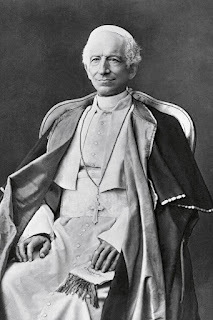 On Monday, June 23 we'll discuss another great anniversary on the Son Rise Rise Morning Show: the 130th anniversary of Pope Leo XIII's Apostolic Letter to England, "Amantissima Voluntatis" ("Most Loving Will") dated on April 27, 1895. You could listen to the letter here.
On Monday, June 23 we'll discuss another great anniversary on the Son Rise Rise Morning Show: the 130th anniversary of Pope Leo XIII's Apostolic Letter to England, "Amantissima Voluntatis" ("Most Loving Will") dated on April 27, 1895. You could listen to the letter here.As usual, I'll be on the air about 7:50 a.m. Eastern/6:50 a.m. Central. Please listen live here or catch the podcast later here.
As the old Catholic Encyclopedia summarizes Pope Leo XIII's activities re: the British Isles (and indeed, the Empire):Among the acts of Leo XIII that affected in a particular way the English-speaking world may be mentioned: for England, the elevation of John Henry Newman to the cardinalate (1879), the "Romanos Pontifices" of 1881 concerning the relations of the hierarchy and the regular clergy, the beatification (1886) of fifty [sic] English martyrs, the celebration of the thirteenth centenary of St. Gregory the Great, Apostle of England (1891), the Encyclicals "Ad Anglos" of 1895, on the return to Catholic unity, and the "Apostolicæ Curæ" of 1896, on the non-validity of the Anglican orders. He restored the Scotch hierarchy in 1878, and in 1898 addressed to the Scotch a very touching letter. In English India Pope Leo established the hierarchy in 1886, and regulated there long-standing conflicts with the Portuguese authorities. In 1903 King Edward VII paid him a visit at the Vatican. The Irish Church experienced his pastoral solicitude on many occasions. His letter to Archbishop McCabe of Dublin (1881), the elevation of the same prelate to the cardinalate in 1882, the calling of the Irish bishops to Rome in 1885, the decree of the Holy Office (13 April, 1888) on the plan of campaign and boycotting, and the subsequent Encyclical of 24 June, 1888, to the Irish hierarchy represent in part his fatherly concern for the Irish people, however diverse the feelings they aroused at the height of the land agitation.
And he named Saint Bede the Venerable a Doctor of the Church in 1889. And Pope Leo XIII declared many Catholic Martyrs of England and Wales blessed or venerable:
In 1886, Pope Leo XIII beatified 54 martyrs, including Thomas More and Bishop John Fisher and 11 others who were canonized in 1970 by Pope Paul VI;In 1886, Pope Leo also declared 29 English Catholic martyrs to be Venerable (several of these martyrs had died in chains, that is, is prison or because of their treatment in prison);In 1895, Pope Leo XIII beatified nine more martyrsSo it's clear that he had many connections to the Catholics of England; in the letter he mentions one English Catholic he'd met, the now-Venerable Servant of God Father Ignatius (Spenser) of St. Paul, who led a Crusade of Prayer for the reunion of all Christians in England with the Catholic Church.Antonia Moffat writes about this letter for EWTN Britain:
On April 27, 1895, Pope Leo XIII wrote a deeply moving letter to the English people, reminding them of their rich Christian heritage and calling for prayer and unity with the Apostolic See. More than 130 years later, his words continue to inspire hope and faith in England today.
The letter was written to remind the English of their Christian heritage, of England’s privileged title as the Dowry of Mary, of the courageous faith of their forefathers and foremothers, and of the historic unity of faith with the Apostolic See of Peter.
How beautiful that a pope should write such a loving letter to the English people – a letter of encouragement, fatherly compassion and deep affection. In many ways, he poured out his heart in love, care and lament before the Living God. And we, the English Catholics and peoples, are the esteemed recipients of this legacy.
In his letter Pope Leo XIII traces the history of the relationship between the universal Catholic Church, especially the Papacy, and the English people from Pope St. Gregory the Great and St. Augustine of Canterbury to the schism and Protestant Reformation and its aftermath (from an unofficial translation):
That the English race was in those days devoted to this centre of Christian unity divinely constituted in the Roman Bishops, and that in the course of ages men of all ranks were bound to them by ties of loyalty, are facts too abundantly and plainly testified by the pages of history to admit of doubt or question. But, in the storms which devastated Catholicity throughout Europe in the sixteenth century, England, too, received a grievous wound; for it was first unhappily wrenched from communication with the Apostolic See, and then was bereft of that holy faith in which for long centuries it had rejoiced and found liberty. It was a sad defection; and Our predecessors, while lamenting it in their earnest love, made every prudent effort to put an end to it, and to mitigate the many evils consequent upon it. It would take long, and it is not necessary, to detail the sedulous and increasing care taken by Our predecessors in those circumstances.
He rejoiced, with some reservations, that Catholics were more able to practice their faith and be active participants in the political and legislative life of England:
We do not doubt that the united and humble supplications of so many to God are hastening the time of further manifestations of His merciful designs towards the English people when the Word of the Lord may run and be glorified. Our confidence is strengthened by observing the legislative and other measures which, if they do not perhaps directly, still do indirectly help forward the end We have in view by ameliorating the condition of the people at large, and by giving effect to the laws of justice and charity.
He commended the Catholics of England and the English people in general, for their concern for "the social issues" he'd highlighted in Rerum Novarum, but urged them to keep in mind the true means of their success:
For the labors of man, whether public or private, will not attain to their full efficacy without appeal to God in prayer and without the divine blessing. For happy is that people whose God is the Lord. For the mind of the Christian should be so turned and fixed that he places and rests the chief hope of his undertakings in the divine help obtained by prayer, whereby human effort is super-naturalized and the desire of doing good, as though quickened by a heavenly fire, manifests itself in vigorous and serviceable actions. In this power of prayer God has not merely dignified man, but with infinite mercy has given him a protector and help in the time of need, ready at hand to all, easy and void of effect to no one who has resolute recourse to it. "Prayer is our powerful weapon, our great protection, our storehouse, our port of refuge, our place of safety."
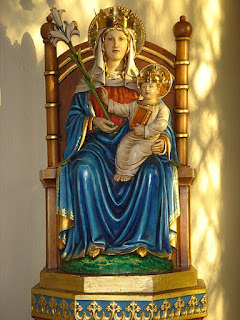 Finally, Pope Leo offered a prayer after invoking the beautiful legacy of England at the "Dowry of Mary" for the reunion of all Christians:
Finally, Pope Leo offered a prayer after invoking the beautiful legacy of England at the "Dowry of Mary" for the reunion of all Christians:O Blessed Virgin Mary, Mother of God and our most gentle Queen and Mother, look down in mercy upon England thy "Dowry" and upon us all who greatly hope and trust in thee. By thee it was that Jesus our Saviour and our hope was given unto the world ; and He has given thee to us that we might hope still more. Plead for us thy children, whom thou didst receive and accept at the foot of the cross. O sorrowful Mother! intercede for our separated brethren, that with us in the one true fold they may be united to the supreme Shepherd, the Vicar of thy Son. Pray for us all, dear Mother, that by faith fruitful in good works we may all deserve to see and praise God, together with thee, in our heavenly home. Amen.
“When England goes back to Walsingham, Our Lady will come back to England" quoth Pope Leo XIII two years later.
Richard II had dedicated England as a Dowry to the Blessed Virgin Mary on June 15, 1381, in the midst of the Peasants Revolt. He knelt before the shrine of Our Lady of Pew in Westminster Abbey and "solemnly declared in Latin: 'Dos tua Virgo pia haec est. Quare rege, Maria.' Which translates as: 'This is your Dowry, O Holy Virgin. Mary, do thou rule in it.'" This action is depicted in the famous and beautiful Wilton Diptych.
Our Lady of Walsingham, pray for us!
Image Credit (Public Domain): Pope Leo XIII (April 11, 1878)
June 12, 2025
Preview: 2025 Anniversaries: Fisher and More, Canonized
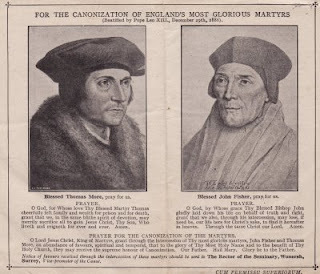
Ninety years ago, Pope Pius XI presided over the canonizations of John Cardinal Fisher and Sir Thomas More in Vatican City on May 19, 1935. It's important to note that Pope Pius XI beatified many other martyrs from the English Reformation and Recusant era (136 on December 15, 1929, witnessed by G.K. Chesterton!) and canonized several other significant men and women during his pontificate (1922-1939): Saints Therese of Lisieux, John Eudes, John Vianney, Robert Bellarmine, Bernadette Soubirous, and the North American/Canadian Jesuit martyrs.
So we'll remember this anniversary on Monday, June 16 on the Son Rise Morning Show. So I'll be on the air at the usual time at about 7:50 a.m. Eastern/6:50 a.m. Central. Please listen live here or catch the podcast later here.
Before we go any further, you have to see this brief video of how men risked life and limb to illuminate Saint Peter's Basilica for the canonization Mass celebrated inside!!
Pope Pius XI spoke of Fisher and More in his homily as being:
the bright champions and the glory of their nation, were given to the Christian people, in the words of the prophet Jeremias, “as a fortified city, and a pillar of iron, and a wall of brass.” Therefore they could not be shaken by the fallacies of heretics, nor frightened by the threats of the powerful. They were, so to speak, the leaders and chieftains of that illustrious band of men who, from all classes of the people and from every part of Great Britain, resisted the new errors with unflinching spirit, and in shedding their blood, testified their loyal devotedness to the Holy See.
Of Saint John Fisher, he contrasted the Cardinal Bishop's pastoral gentleness with his doctrinal and moral zeal:
Nevertheless, whilst he was meek and affable towards the afflicted and the suffering, whenever there was question of defending the integrity of faith and morals, like a second Precursor of the Lord, in whose name he gloried, he was not afraid to proclaim the truth openly, and to defend by every means in his power the divine teachings of the Church. You are well aware, Venerable Brethren and Beloved Sons, of the reason why John Fisher was called in judgment and obliged to undergo the supreme test of martyrdom. It was because of his courageous determination to defend the sacred bond of Christian marriage—a bond indissoluble for all, even for those who wear the royal diadem—and to vindicate the Primacy with which the Roman Pontiffs are invested by divine command.
Of the layman, Thomas More, he praised the continuity of his life and death:
Endowed with the keenest of minds and supreme versatility in every kind of knowledge, he enjoyed such esteem and favour among his fellow-citizens that he was soon able to reach the highest grades of public office. But he was no less distinguished for his desire of Christian perfection and his zeal for the salvation of souls. Of this we have testimony in the ardour of his prayer, in the fervour with which he recited, whenever he could, even the Canonical Hours, in the practice of those penances by which he kept his body in subjection, and finally in the numerous and renowned accomplishments of both the spoken and the written word which he achieved for the defence of the Catholic faith and for the safeguarding of Christian morality.
A strong and courageous spirit, like John Fisher, when he saw that the doctrines of the Church were gravely endangered, he knew how to despise resolutely the flattery of human respect, how to resist, in accordance with his duty, the supreme head of the State when there was question of things commanded by God and the Church, and how to renounce with dignity the high office with which he was invested. It was for these motives that he too was imprisoned, nor could the tears of his wife and children make him swerve from the path of truth and virtue.
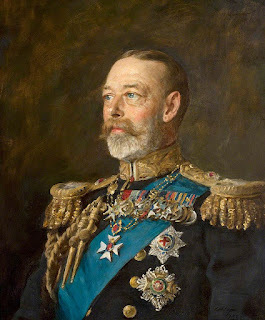 Of course, this event was not without controversy: in Great Britain, King George V and Queen Mary were celebrating their Silver Jubilee; Catholics had just been granted more rights in 1929--being allowed to include bequests in their last wills and testaments for Masses said after their deaths for example--and this raising of two Englishmen who had defied their King and Parliament could raise some hackles.
Of course, this event was not without controversy: in Great Britain, King George V and Queen Mary were celebrating their Silver Jubilee; Catholics had just been granted more rights in 1929--being allowed to include bequests in their last wills and testaments for Masses said after their deaths for example--and this raising of two Englishmen who had defied their King and Parliament could raise some hackles. Arthur Cardinal Hinsley, the Archbishop of Westminster (1935-1943) even "asked the British Minister to the Holy See, Sir Charles Wingfield whether it would be possible for the king to send a special mission to the canonisation ceremony to highlight the special patriotic loyalty of the English and Welsh Catholic community" according to Moloney, Thomas, Westminster, Whitehall and the Vatican: the Role of Cardinal Hinsley 1938–1943, (London, 1985), p. 41." which could be considered rather bold!
But King George V, like his father Edward VII before him, had wanted the anti-Catholic denunciations to be removed from the Parliamentary/Coronation Oath he was required to make, and they were, in the "Act to alter the form of the Declaration required to be made by the Sovereign on Accession" in 1910, so perhaps he was not offended at all. But unlike the canonization of Saint John Henry Newman, which then Prince Charles attended, I found no indication that any official delegation attended in 1935.
You might recall that when Pope Benedict XVI made his state visit to Scotland and England during which he beatified John Henry Newman, there was a diplomatic incident, when an internal memo got out:
The memo suggested that Pope Benedict XVI, during his visit, could launch a range of branded condoms, visit an abortion clinic, bless a gay marriage and apologise for the Spanish Armada.[3] The cover note to the memo read "Please protect; these should not be shared externally. The 'ideal visit' paper in particular was the product of a brainstorm which took into account even the most far-fetched of ideas."
Perhaps not all brainstorming sessions should be documented. The government apologized, of course.
Saint John Fisher, pray for us!
Saint Thomas More, pray for us!
Note that 25 years ago, Pope Saint John Paul II declared St. Thomas More Patron of Statesmen and Politicians (October 31, 2000). The anniversaries just keep coming! And in my research for this post I found this article about St. Thomas More as one of the intercessors for Opus Dei!
Image Source (Public Domain): Portrait of King/Emperor George V by Arthur Stockdale Cope, 1933
June 5, 2025
2025 Anniversaries: Fisher and More, 490 Years Ago
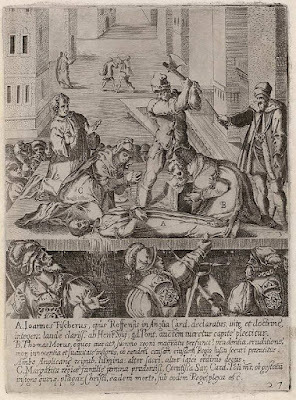 As we resume our 2025 anniversaries series on the Son Rise Morning Show, the first of two significant anniversaries for Saint John Fisher and Saint Thomas More: 490 years since their martyrdoms on June 22 and July 6, respectively, in 1535.
As we resume our 2025 anniversaries series on the Son Rise Morning Show, the first of two significant anniversaries for Saint John Fisher and Saint Thomas More: 490 years since their martyrdoms on June 22 and July 6, respectively, in 1535. So I'll be on the Son Rise Morning Show on Monday, June 9 at the usual time at about 7:50 a.m. Eastern/6:50 a.m. Central. Please listen live here or catch the podcast later here.
We'll mark the second significant anniversary, the 90th of their canonizations in 1935, the following Monday, June 16.
In preparing for these anniversaries, I've read two books about Saint Thomas, by Travis Curtright and from Cluny Press, and I'm still reading a great book by Saint John Fisher, defending the Catholic doctrine of the Real Presence of Jesus in the Blessed Sacrament. There's another new book translating Fisher's defense of Free Will against Martin Luther's ideas, but it's a little out of my price range (but very important). What these four books demonstrate is that these two martyrs were actively defending the teachings of the Catholic Church before and, in More's case, while they were already suffering for their defense of the Unity of the Church with the Vicar of Christ, the Pope.
What Travis Curtright's book emphasized for me is that Henry VIII and Thomas Cromwell targeted Sir Thomas More in the November 1534 Supremacy Act and Treasons Act by eliminating his defense of Silence against disclosing his reasons for not swearing the required oaths. The Treasons Act described the reach of the law that silence could not protect, in the wish, the will, the desire, the imagination, the invention, the practice or attempt to harm Henry VIII's "dignity, title [Supreme Head of the Church in England] or name", finding guilty anyone who
do [sic] maliciously wish, will or desire by words or writing, or by craft imagine, invent, practise, or attempt any bodily harm to be done or committed to the king's most royal person, the queen's or the heirs apparent, or to deprive them of any of their dignity, title or name of their royal estates, or slanderously and maliciously publish and pronounce, by express writing or words, that the king should be heretic, schismatic, tyrant, infidel or usurper of the crown . . .thus they presumed to read his mind and the law implied treason IN his silence. Curtright's comment: "Spoken malice could be determined by any rejection of or refusal to admit to the king's title in the Treasons Act, and this same language of sedition was part of More's attainder . . ." (p. 113) Spoken malice need not be be stated out loud; it was implied and implicated by silence (?!?). Note that the publication and pronouncement of this harm of the king, queen, or heir is mentioned after the word "or": the first violation is as bad as the second.
As Curtright notes, Saint John Fisher, good and holy bishop that he was, was not the lawyer that More was, and thus Sir Richard Rich tricked him into speaking against the King's ecclesiastical title and control of the Church in/of England: Rich promised that "Fisher would suffer no harm for" giving his opinion about the King's new title because Henry VIII "desired to hear it". Offering an opinion could be charged as treason. (footnote #33 to page 112 on page 199). This was entrapment.
Thomas More protested at his trial not only that he was never malicious but that he and Richard Rich were only conducting a legal "moot"--arguing a case without reference to a real case, a "what if" conditional scenario in the Tower of London, and he famously commented:
Can it therefore seem likely to your Lordships, that I should in so weighty an Affair as this, act so unadvisedly, as to trust Mr. Rich, a Man I had always so mean an Opinion of, in reference to his Truth and Honesty, so very much before my Sovereign Lord the King, to whom I am so deeply indebted for his manifold Favours, or any of his noble and grave Counselors, that I should only impart to Mr. Rich the Secrets of my Conscience in respect to the King's Supremacy, the particular Secrets, and only Point about which I have been so long pressed to explain my self? which I never did, nor never would reveal; when the Act was once made, either to the King himself, or any of his Privy-Counselors, as is well known to your Honours, who have been sent upon no other account at several times by his Majesty to me in the Tower. I refer it to your Judgments, my Lords, whether this can seem credible to any of your Lordships.
But both Fisher and More were found guilty at their trials. Through the years I've contributed to the Son Rise Morning Show program we've described their martyrdoms, but here's some narration of Saint John Fisher's last moments:
When he came out of the Tower, a summer morning's mist hung over the river, wreathing the buildings in a golden haze. Two of the Lieutenant's men carried him in a chair to the gate, and there they set him down, while waiting for the Sheriffs. The cardinal stood up and leaning his shoulder against a wall for support, opened the little New Testament he carried in his hand. "O Lord," he said, so that all could hear him, "this is the last time I shall ever open this book. Let some comforting place now chance to me whereby I, Thy poor servant, may glorify Thee in my last hour"----and looking down at the page, he read
Now this is eternal life: that they may know Thee, the one true God, and Jesus Christ Whom Thou has sent I have glorified Thee on earth: I have finished the work which Thou gavest me to do (John, 17:3-4).
Whereupon he shut the book, saying: "Here is even learning enough for me to my life's end." His lips were moving in prayer, as they carried him to Tower Hill. . . .
He was offered a final chance to save his life by acknowledging the royal supremacy, but the Saint turned to the crowd, and from the front of the scaffold, he spoke these words:
"Christian people, I am come hither to die for the faith of Christ's Catholic Church, and I thank God hitherto my courage hath served me well thereto, so that yet hitherto I have not feared death; wherefore I desire you help me and assist me with your prayers, that at the very point and instant of my death's stroke, and in the very moment of my death, I then faint not in any point of the Catholic Faith for fear; and I pray God save the king and the realm, and hold His holy hand over it, and send the king a good counsel."
Witnesses were shocked at how thin and weak he was and at how much blood poured out of his body after the beheading. His decollated body was left on the scaffold on Tower Hill.
Saint John Fisher, pray for us!
Saint Thomas More, pray for us!
Image Source (Public Domain): Drawing of one the frescoes by Niccolò Circignani in the Venerable English College in Rome, depicting the executions of Saint John Fisher, Saint Thomas More, and Blessed Margaret Pole (which did not take place at the same time!) A=Fisher beheaded; B=More being beheaded; C=Pole, next to be beheaded.



